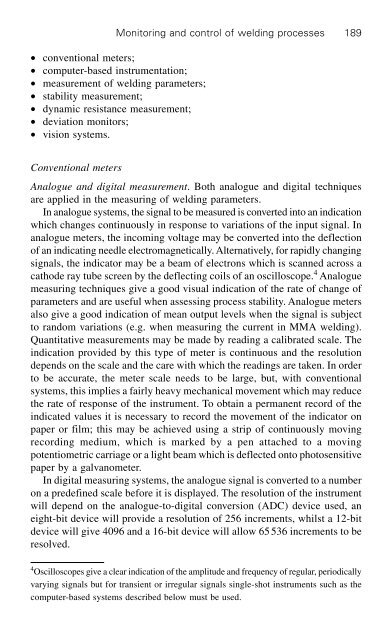Advanced Welding Processes: Technologies and Process Control
Advanced Welding Processes: Technologies and Process Control
Advanced Welding Processes: Technologies and Process Control
Create successful ePaper yourself
Turn your PDF publications into a flip-book with our unique Google optimized e-Paper software.
Monitoring <strong>and</strong> control of welding processes 189<br />
∑ conventional meters;<br />
∑ computer-based instrumentation;<br />
∑ measurement of welding parameters;<br />
∑ stability measurement;<br />
∑ dynamic resistance measurement;<br />
∑ deviation monitors;<br />
∑ vision systems.<br />
Conventional meters<br />
Analogue <strong>and</strong> digital measurement. Both analogue <strong>and</strong> digital techniques<br />
are applied in the measuring of welding parameters.<br />
In analogue systems, the signal to be measured is converted into an indication<br />
which changes continuously in response to variations of the input signal. In<br />
analogue meters, the incoming voltage may be converted into the deflection<br />
of an indicating needle electromagnetically. Alternatively, for rapidly changing<br />
signals, the indicator may be a beam of electrons which is scanned across a<br />
cathode ray tube screen by the deflecting coils of an oscilloscope. 4 Analogue<br />
measuring techniques give a good visual indication of the rate of change of<br />
parameters <strong>and</strong> are useful when assessing process stability. Analogue meters<br />
also give a good indication of mean output levels when the signal is subject<br />
to r<strong>and</strong>om variations (e.g. when measuring the current in MMA welding).<br />
Quantitative measurements may be made by reading a calibrated scale. The<br />
indication provided by this type of meter is continuous <strong>and</strong> the resolution<br />
depends on the scale <strong>and</strong> the care with which the readings are taken. In order<br />
to be accurate, the meter scale needs to be large, but, with conventional<br />
systems, this implies a fairly heavy mechanical movement which may reduce<br />
the rate of response of the instrument. To obtain a permanent record of the<br />
indicated values it is necessary to record the movement of the indicator on<br />
paper or film; this may be achieved using a strip of continuously moving<br />
recording medium, which is marked by a pen attached to a moving<br />
potentiometric carriage or a light beam which is deflected onto photosensitive<br />
paper by a galvanometer.<br />
In digital measuring systems, the analogue signal is converted to a number<br />
on a predefined scale before it is displayed. The resolution of the instrument<br />
will depend on the analogue-to-digital conversion (ADC) device used, an<br />
eight-bit device will provide a resolution of 256 increments, whilst a 12-bit<br />
device will give 4096 <strong>and</strong> a 16-bit device will allow 65536 increments to be<br />
resolved.<br />
4 Oscilloscopes give a clear indication of the amplitude <strong>and</strong> frequency of regular, periodically<br />
varying signals but for transient or irregular signals single-shot instruments such as the<br />
computer-based systems described below must be used.


